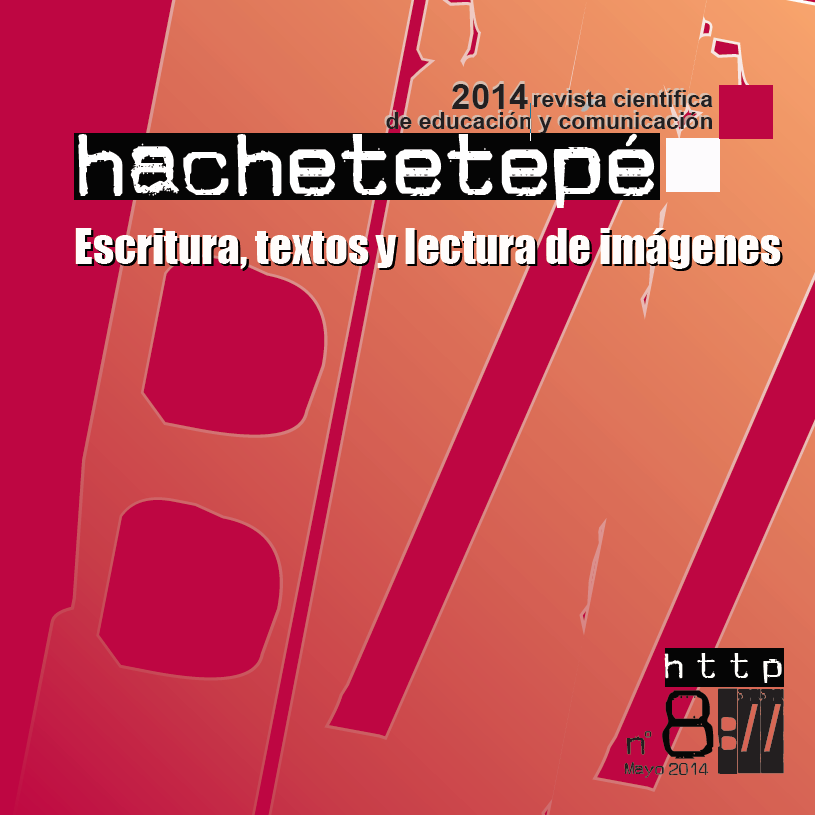T.v. shows as a resourcetodevelopthecontents of theSpanishLanguage and LiteratureAtrapa un… punto,educationaltelevision 1º ESO

Info
Abstract
Multiple are the news, articles and investigations that focus on the existing relation between the infancy, the adolescence and the television. And it has a logic, according to the last statistics almost three hours of average pass a day in front of the screen. And what do they see? The hearings indicate us a series of programs that we might determine as slightly productive models and, as minimum, worrying for families and teachers. Nevertheless, also there exist programs of success that not only they entertain, but they can be taken to the classroom as didactic tool. In this experience there are consolidated the contents of Language and Literature across the adjustment of a program of success of the national television.
Keywords
Downloads
How to Cite
License

This work is licensed under a Creative Commons Attribution-NonCommercial-NoDerivatives 4.0 International License.
Those authors who have published with this journal, accept the following terms:
- They will retain their copyright and guarantee the journal the right to first publication of their work, which will simultaneously be subject to the Creative Commons Attribution License . They may be copied, used, disseminated, transmitted and publicly displayed, provided that the authorship, url, and magazine are cited, and are not used for commercial purposes. No derivative works are allowed.
- They may adopt other non-exclusive license agreements for the distribution of the published version of the work (e.g., deposit it in an institutional telematic archive or publish it in a monographic volume) provided that the initial publication in this journal is indicated.
- Disseminate your work through the Internet (e.g., in institutional telematic archives or on your website) once the manuscript is accepted, which may lead to interesting exchanges and increased citations of the published work. (See The effect of open access).
Hachetetepé. Scientific journal of education and communication does not charge a fee for the submission of manuscripts or for the publication of its articles.
References
Alonso Martín, Mª del Cr. (2010). “Variables del aprendizaje significativo para el desarrollo de las competencias básicas”. En Seminario de Prácticas del profesorado.
Amar, V. (2008). Tecnologías de la Información y la Comunicación, Sociedad y Educación. Madrid: Tébar.
Calderón-Rehecho, A. (2012): “Pensando en TIC... desde la biblioteca”. En Hachetetepé, 4. http://grupoeducom.com/pensando-en-tic-desde-la-biblioteca/ (Recuperado el 27 de diciembre de 2013).
Cassany, D., Luna, M. y Sanz, G. (2002). Enseñar Lengua. Barcelona: Graò.
Gomes, A. R. (2012) “Lectura de imagen y aprendizaje significativo”.En Hachetetepé, 4. http://grupoeducom.com/lectura-de-imagen-y-aprendizaje-significativo/ (Recuperada el 27 de diciembre de 2013).
Jacquet, J. y Casulleras, S. (2010). 40 juegos para practicar la lengua española. Barcelona: Graò.
Romero, M. Fr. (2008). “El Romanticismo en la música actual”. En Cuadernos de Pedagogía, 384.
Ruiz Bikandi, U. (2011). Didáctica de la Lengua castellana y la Literatura. Barcelona: Graò.
Sánchez Benítez, G. (2010). “Las estrategias de aprendizaje a través del componente lúdico”. En Suplementos marco ELE, 11. http://marcoele.com/descargas/11/sanchez-estrategias-ludico.pdf (Recuperada el 3 de enero de 2014).

